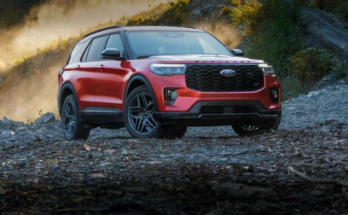Technological advancements, shifting consumer demands, and regulatory changes are driving a profound transformation in the automotive industry. The landscape is rapidly evolving, with electric vehicles (EVs), autonomous driving, and connected car technologies at the forefront. This article delves into the latest industry updates and trends shaping the future of mobility, offering insights into the developments that are redefining the way we think about transportation.
1. The Surge in Electric Vehicles (EVs)
Electric vehicles have taken center stage as automakers and consumers alike shift their focus toward sustainable and environmentally friendly transportation options. Major automotive manufacturers, such as Tesla, Ford, and Volkswagen, are aggressively expanding their EV lineups, investing billions of dollars in research and development.
One of the most significant developments in this space is the introduction of new EV models with extended range and improved battery technology. The push towards solid-state batteries, which promise higher energy density, faster charging times, and enhanced safety, is a key trend. Companies like Toyota and QuantumScape are leading the charge in bringing these next-generation batteries to market.
Government policies and incentives are also playing a crucial role in accelerating the adoption of EVs. Several countries have announced plans to phase out internal combustion engine (ICE) vehicles within the next two decades. This has prompted automakers to ramp up their EV production capacities to meet the growing demand.
Key Points:
- Expansion of EV models by major automakers.
- Advances in battery technology, including solid-state batteries.
- Government policies promote EV adoption.
2. Autonomous Driving: The Road to Self-Driving Cars
Autonomous driving technology is another transformative trend in the automotive industry. Companies like Waymo, Tesla, and Uber are at the forefront of developing self-driving cars with varying levels of automation.
The progression from Level 2 (partial automation) to Level 5 (full automation) is gradual but inevitable. Currently, most autonomous vehicles on the road are at Level 2 or Level 3, where the driver must remain engaged and ready to take control if needed. However, significant strides are being made toward Level 4 and Level 5 autonomy, where the vehicle can operate independently without human intervention.
Artificial intelligence (AI) and machine learning are critical components in the development of autonomous vehicles. These technologies enable cars to learn from vast amounts of data, recognize patterns, and make real-time decisions. The deployment of 5G networks is also crucial, as it provides the low-latency communication necessary for safe and efficient autonomous driving.
Safety remains a primary concern as the industry moves toward full automation. Regulators are working closely with automakers to establish safety standards and testing protocols. The challenge is to create a legal and ethical framework that addresses the complexities of autonomous driving, such as decision-making in emergency situations.
Key Points:
- Gradual transition from Level 2 to Level 5 autonomy.
- Role of AI, machine learning, and 5G in autonomous driving.
- Regulatory challenges and safety concerns.
3. The Rise of Connected Cars
Connected cars represent a significant shift in how vehicles interact with their environment and the drivers who operate them. These vehicles are equipped with internet connectivity and sensors that allow them to communicate with other vehicles, infrastructure, and cloud services.
Vehicle-to-Everything (V2X) communication is a key component of connected car technology. V2X enables vehicles to share information with each other and with roadside infrastructure, such as traffic lights and road signs. This technology enhances road safety, reduces traffic congestion, and improves overall driving efficiency.
The integration of connected car technology with smart cities is another exciting development. In smart cities, connected vehicles can interact with traffic management systems to optimize traffic flow, reduce emissions, and improve the overall urban mobility experience.
Cybersecurity is a major concern in the connected car ecosystem. As vehicles become more connected, they also become more vulnerable to cyberattacks. Automakers are investing heavily in cybersecurity measures to protect vehicles and their occupants from potential threats.
Key Points:
- Vehicle-to-Everything (V2X) communication and its benefits.
- Integration with smart cities and urban mobility.
- Cybersecurity challenges in connected car technology.
4. Sustainable Manufacturing and Materials
Sustainability is no longer a buzzword in the automotive industry; it is a core principle driving innovation across the sector. Automakers are adopting sustainable manufacturing practices and exploring the use of eco-friendly materials in vehicle production.
Recycled and bio-based materials are becoming increasingly popular as manufacturers seek to reduce their environmental footprint. For instance, BMW has introduced a concept car made from recyclable materials, showcasing the potential for sustainability in automotive design. Companies are also exploring alternatives to traditional leather, such as vegan leather made from plant-based materials.
Energy-efficient production processes are another focus area. Automakers are investing in renewable energy sources, such as solar and wind power, to reduce the carbon footprint of their manufacturing plants. The adoption of circular economy principles, where materials are reused and recycled throughout the production process, is also gaining traction.
Sustainable manufacturing extends beyond the production line. Automakers are working on reducing the environmental impact of their supply chains by sourcing materials locally and minimizing waste.
Key Points:
- Use of recycled and bio-based materials in vehicle production.
- Energy-efficient manufacturing processes.
- Circular economy principles in the automotive industry.
5. The Shift Towards Mobility as a Service (MaaS)
Mobility as a Service (MaaS) is redefining the traditional concept of vehicle ownership. Instead of owning a car, consumers are increasingly opting for flexible, on-demand transportation services. Urbanization, shifting consumer preferences, and technological advancements are the driving forces behind this change.
Ride-hailing services, such as Uber and Lyft, are prime examples of MaaS. These platforms offer consumers the convenience of accessing transportation at the touch of a button, without the hassles of vehicle ownership. Car-sharing services, like Zipcar, are also gaining popularity, particularly in urban areas where parking is limited and the cost of ownership is high.
Automakers are recognizing the potential of MaaS and are investing in their mobility services. General Motors’ Maven and Ford’s Chariot are examples of automaker-led initiatives in this space. The focus is on providing consumers with a seamless, integrated transportation experience that combines ride-hailing, car-sharing, and other mobility options.
The future of MaaS lies in the integration of various transportation modes into a single platform. Consumers will be able to plan, book, and pay for their transportation needs through a single app, whether it’s a ride-hailing service, public transit, or bike-sharing.
Key Points:
- Growth of ride-hailing and car-sharing services.
- Automaker invests in mobility services.
- Integration of transportation modes into a single MaaS platform.
6. The Impact of Regulatory Changes
Regulatory changes are having a profound impact on the automotive industry, influencing everything from vehicle emissions to safety standards. Governments around the world are implementing stricter regulations to address environmental concerns and enhance road safety.
One of the most significant regulatory trends is the push for lower vehicle emissions. The European Union, for instance, has set ambitious targets for reducing CO2 emissions from new cars. These regulations are forcing automakers to accelerate their transition to electric and hybrid vehicles.
Safety regulations are also evolving to keep pace with advancements in automotive technology. The introduction of mandatory features, such as advanced driver assistance systems (ADAS), is aimed at reducing accidents and improving road safety. Automated emergency braking, lane-keeping assistance, and adaptive cruise control are examples of ADAS technologies that are becoming standard in new vehicles.
Regulatory changes are not limited to emissions and safety. Data privacy and cybersecurity regulations are becoming increasingly important as vehicles become more connected. Automakers must comply with a complex web of regulations to protect consumer data and ensure the security of their vehicles.
Key Points:
- Stricter emissions regulations driving the shift to electric and hybrid vehicles.
- Evolving safety standards and mandatory ADAS features.
- Data privacy and cybersecurity regulations in the connected car era.
7. The Role of Startups and Tech Giants
Startups and tech giants are playing an increasingly important role in the automotive industry, driving innovation and challenging traditional automakers. Companies like Tesla, Rivian, and Lucid Motors have disrupted the industry with their innovative approaches to electric vehicles and autonomous driving.
Tech giants such as Google, Apple, and Amazon are also making their mark on the automotive sector. Google’s Waymo is a leader in autonomous driving technology, while Apple is reportedly working on its own electric vehicle project, often referred to as “Project Titan.” Amazon, through its investment in Rivian and its development of delivery drones, is exploring new ways to revolutionize transportation and logistics.
These companies bring a different perspective to the automotive industry, leveraging their expertise in software, AI, and consumer electronics. Their entry into the market has spurred traditional automakers to accelerate their innovation efforts and embrace new technologies.
Collaboration between automakers and tech companies is becoming increasingly common. Partnerships like the one between General Motors and Microsoft, focused on cloud computing and AI for autonomous vehicles, exemplify the convergence of the automotive and tech industries.
Key Points:
- Disruption by startups like Tesla, Rivian, and Lucid Motors.
- Tech giants’ involvement in the automotive sector.
- Collaboration between automakers and tech companies.
8. Global Supply Chain Challenges
The global automotive supply chain has faced unprecedented challenges in recent years, from semiconductor shortages to disruptions caused by the COVID-19 pandemic. These challenges have highlighted the vulnerabilities in the supply chain and prompted automakers to rethink their strategies.
Semiconductor shortages, in particular, have had a significant impact on vehicle production. The automotive industry relies heavily on semiconductors for various components, including infotainment systems, safety features, and powertrains. The shortage has led to production delays and reduced vehicle availability, affecting automakers worldwide.
To mitigate these challenges, automakers are diversifying their supply chains and investing in local production facilities. There is also a growing emphasis on developing in-house capabilities for critical components, such as semiconductors and batteries, to reduce dependency on external suppliers.
The shift towards electric vehicles is adding complexity to the supply chain as the demand for materials like lithium, cobalt, and nickel increases. Automakers are exploring new sources of these materials and investing in recycling technologies to ensure a stable supply.
Key Points:
- Impact of semiconductor shortages on vehicle production.
- Strategies for supply chain diversification and local production.
- Challenges related to sourcing materials for electric vehicles.
9. Consumer Preferences and Market Dynamics
Technological advancements, environmental concerns, and shifting lifestyles are all driving rapid changes in consumer preferences. These shifts are reshaping the automotive market and influencing the types of vehicles that consumers are choosing.
The demand for SUVs and crossovers continues to rise, particularly in markets like the United States and China. These vehicles offer a combination of space, comfort, and versatility that appeals to a broad range of consumers. However, there is also a growing interest in smaller, more fuel-efficient vehicles, particularly in urban areas where space is limited.
Electric vehicles are gaining traction among consumers, who are increasingly concerned about their environmental impact. The availability of government incentives, coupled with the expanding charging infrastructure, is making EVs a more attractive option for a wider audience.
The trend toward personalization is another key factor shaping consumer preferences. Automakers are offering more customization options, allowing consumers to tailor their vehicles to their specific needs and tastes. This includes everything from exterior color choices to advanced in-car technologies.
Economic factors like interest rates and fuel prices also have an impact on market dynamics. Fluctuations in these areas can have a significant impact on vehicle sales and consumer buying behavior.
Key Points:
- Rising demand for SUVs and crossovers.
- Growing interest in electric vehicles.
- Trend toward vehicle personalization.
10. The Future of Automotive Design
Automotive design is undergoing a transformation as new technologies and materials become available. The shift towards electric vehicles is driving changes in vehicle architecture as designers have more freedom to explore new forms and layouts.
The absence of a traditional internal combustion engine allows for more innovative designs, with a focus on aerodynamics and interior space. This has led to the creation of vehicles with sleek, futuristic profiles and spacious, minimalist interiors.
Sustainability is also influencing automotive design. Designers are increasingly incorporating eco-friendly materials and sustainable practices into their work. This includes the use of recycled materials, energy-efficient manufacturing processes, and designs that prioritize recyclability at the end of the vehicle’s life cycle.
Autonomous driving technology is another factor shaping the future of automotive design. As vehicles become more autonomous, the focus will shift from the driving experience to the passenger experience. This could lead to the development of new interior layouts that prioritize comfort, entertainment, and productivity.
Key Points:
- Impact of electric vehicles on vehicle design.
- Incorporation of sustainable materials and practices.
- Influence of autonomous driving on interior design.
FAQ Section
What are the main trends shaping the automotive industry today?
The rise of electric vehicles (EVs), the development of autonomous driving technology, the expansion of connected cars, and the shift toward mobility as a service (MaaS) are a few major trends that are influencing the automotive industry. Sustainability, regulatory changes, and consumer preferences are also playing significant roles.
How is the adoption of electric vehicles impacting the automotive industry?
The adoption of electric vehicles is driving significant changes in the automotive industry. Automakers are expanding their EV lineups, investing in battery technology, and adjusting their manufacturing processes to meet the growing demand. Government incentives and stricter emissions regulations are also accelerating the transition to electric vehicles.
What challenges is the automotive supply chain facing?
The automotive supply chain is facing challenges such as semiconductor shortages, disruptions from the COVID-19 pandemic, and the increasing demand for materials needed for electric vehicle production. Automakers are responding by diversifying their supply chains, investing in local production, and developing in-house capabilities for critical components.
How are consumer preferences influencing the automotive market?
Consumer preferences are driving demand for SUVs and crossovers, electric vehicles, and personalized options. Environmental concerns, urbanization, and technological advancements are influencing the types of vehicles that consumers are choosing, leading to a shift in market dynamics.
What role are startups and tech giants playing in the automotive industry?
Startups and tech giants are driving innovation in the automotive industry, particularly in areas like electric vehicles and autonomous driving. Companies like Tesla, Rivian, Google, and Apple are challenging traditional automakers and accelerating the pace of technological advancements in the sector.



